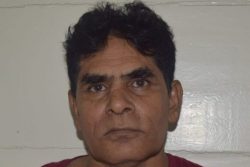With GPL set to finish replanting its cable to reconnect the Vreed-en-Hoop power station with its Kingston facility, a longtime mechanical and electrical engineer says that the utility should have found a new path as it is at risk of being damaged again.
The cable was severed in a dredging operation on July 12 this year.
Engineer Cyril Walker told Stabroek News that the cable is “going to cut again” if the Guyana Power and Light (GPL) does not opt to have it moved to another location. “We are in the estuary of a major river in the middle of the harbour where vessels heavily transverse and park. Every time they lay and bring up their anchor the cable is at risk of being damaged and they have to fix it at great costs,” Walker explained to Stabroek News last week.
Walker said that during the late fifties and sixties they experienced a submarine cable bursting at least three times a year. “It was very expensive to fix and the Harbour Master then dredged it from 19 ft to 22 ft but every time you put back a new cable the ships would eventually burst it,” he noted. He said that after he did some research he found that the silt in the river had a major influence in the cable being damaged.
“The river brought down a lot of silt. So much stuff comes down and I am of the firm belief that the movement of that stuff shifts the cable and raises it. We used to dig it and then put some concrete anchors to hold the thing down from coming up and it would still be damaged,” he said, stating that he is suggesting that the company find a new location, which has less traffic, to lay the cable.
He posited that another option for the power company to take was to run overhead lines and poles from Vreed-en-Hoop to Vriesland, which are about 9 miles apart, and then have a cable go across the river to New Hope on the East Bank. “Once it goes across the river then you can have two switch stations before and after to operate the industrial parks that are popping up. And now if they have any faults you can isolate the problem and fix it right there without causing any problems,” he said.
“The 69 Kv lines could have been extended from Vreed-en-Hoop to Vries-land and a substation placed behind Hutsonville. This substation would now have been able to cater for the needs of industrial development of the middle East Bank corridor,” he added.
He contended that the area between Vriesland and New Hope only has ships passing and none of them would stop and put the cable in jeopardy.
Walker stated that his suggestion would also be economically viable since it would cost less than the option GPL is currently exploring. He said that since the distance between Vriesland and New Hope was significantly shorter, the amount they would have to spend on the cable would significantly decrease.
With reference to the recent power outages, Walker said that one of the main reasons for them was that the power company did not have a comprehensive maintenance programme. He charged that it did not make regular checks on the poles and transmission lines and would often only act when there are problems.
No response
Stabroek News tried to contact the management of GPL for several days last week on these issues but there was no response.
The cable was completed in March 2012 as part of a US$5 million project for the upgrade of transmission and distribution systems under a US$42 million loan and has the capacity to deliver over 150 megawatts to West Demerara.
Then CEO of the power company Bharat Dindyal had explained that the biggest challenge to laying the cable was having to deal with an active channel.
Prior to the laying of the present cable, the former Guyana Electricity Cor-poration had a 12 Kv cable connecting the power stations to the West Deme-rara. However, the cable was frequently damaged by passing ships and anchors.
While the 2012 cable was cut in July this year, GPL has said that it expected to finish repairing it by November 23.
Damage to the cable has meant that 16 Megawatts (MW) cannot be transmitted from Vreed-en-Hoop, West Demerara to the power grid in Georgetown.
In September this year, Minister of Public Infra-structure David Patterson said that while at the time contractual arrangements determined that the 2012 cable be buried to a depth of 3 meters, it has since been suggested by the Maritime Administration Department (MARAD) that it be buried deeper. He revealed that with plans to dredge the channel, which at present is 6 meters deep, and which MARAD plans to take to a nine to ten meter depth, adjustments will have to be made as this could lead to exposure of the cable.
“MARAD at the time, I think when the contract was going on, had advised that it should be lower because they would like to proceed with dredging the channels…However, the contract was signed already, so it remained at 3 meters. I was told just now, prior to this, that there are excess cables at either end…so that at a particular time, at the cost of the company, they will bury it the further required depth of no less than 6 meters,” he added.
The minister stated that he has also asked GPL to explore the option of having a second cable installed.








